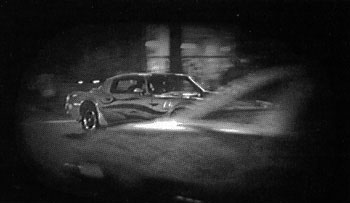Ellard and Johnstone
Cornerhouse, Manchester, UK
Art Monthly, Issue 230, Oct 1999

Image: Ellard and Johnstone, Wall of Death, (detail)
Pushing through the doors to the gallery we find it dimly lit and empty. Police sirens and the roar of revving engines emanate from the back of the space. That must be the work: Wall of Death. Following these sounds we find that the far end of the gallery - the darkest bit - contains a large circular structure: all timber struts like the back of a stage set. It's about four metres high and eight metres in diameter, nestled into the back of the space so we can't walk round it. It has a pair of doors. Pulling them open we enter a minor theme park experience.
'Go! Go! Go!' A long screech of tyres. The dark whine of engines running flat out in top gear. 'Stop, police!' Gunshots. The deep smash of crumpling bodywork. Sirens. A truck's airhorn. The muffled roar of helicopter blades. 'What the hell's going on down there?' High tempo rock drumming. Wild! It's a 70s car chase. Two video projections opposite each other track round the wall showing chase scenes from Hollywood movies. The images are almost circular, like searchlights.
A flame-painted car shrieks round car parks and alleyways, taking out the usual trash cans and cardboard boxes before vaulting off a ramp. Wheels in the air, its roof hits the ground. Cop cars make a mess of chasing a white vehicle along interstate highways. The car, one of those powerful American models so mysterious to British audiences (a Mustang or a Chevy or a Dodge), does little but travel exceedingly fast. The driver, in close-up, is utterly calm; he concentrates on the road ahead, seemingly oblivious of the chaos behind and the helicopter above. There are chases on foot too: figures running up stairs, diving through doorways, looking frantically around. There's even Gene Hackman running for a train, and missing it. I don't know which films these scenes are from, and I'm glad.
The two projectors hang from the ceiling on a slowly rotating platform. Four speakers line the circumference of the screen. The images move from left to right at walking pace, the sound follows them. Technologically, it's an extraordinarily sophisticated work: the pursuers and the pursued have been chopped out of the films and edited back together opposite each other. Some parts of the film have been slowed slightly, the colour contrast heightened. We are barely aware of these subtleties, which is precisely what's so impressive: we experience the artwork not just the gadgetry.
But what is this artwork? Is it a celebration of the chase scene in Hollywood movies? Well, yes, in part it is. As we walk around the space following the action, we are caught up in the thrilling disorientation of the spectacle. So yes, it is a celebration. But it is also a critique, showing the limits of such entertainment. The 'wall of death' metaphor relates the chase scene to the pure spectacle of fairground attractions - thrilling but hollow.
It is a truism that most people watch motorsport in order to see the crashes. But when TV executives decide that therefore the best programmes are ones that just show crashes, they are simplifying human desire to a facile shallowness. A crash is thrilling, yes, but it is only truly powerful when seen in the context of a long and often boring race. In fact, the more boring the race, the more interesting the crash. Hence the impoverished thrill of such TV shows as Police Camera Action. It is like bingeing on sweeties: leaving us wired and jittery but also unsatisfied, empty and nauseous.
Happily, Wall of Death is not didactic. It lets us draw our own conclusions as we become inevitably more involved in some clips than others. Who is the man in the white car? How come he is so composed when a helicopter is tailing him? How could he possibly escape? I bet he does ... but where to? Yes we are enjoying the adrenaline of the spectacle, but it is these narrative elements that actually make us care about the chase. Obviously a chase scene is a high point in a film, but such peaks are meaningless without the lows and, more importantly, the ascent.
We are drawn to the speeding white car because of its narrative implications: it is speeding towards some kind of future. The most spectacular scenes - when there are outrageous crashes - trap us in the moment; crashes are simply about kinetic energy being given over to chaos, about a massive expenditure of energy, like a rollercoaster. We feel a tightness because we understand the danger, but it is the moment, the instant, that we are caught in, implying no future and little past. But this white car ... well that implies a future, a kind of utopia, something worth getting to - fast. This artwork shows that even when the storyline is stripped away, we still respond to a narrative drive. We identify with it, are compelled by it, require it. Yes we enjoy the spectacular, but only when it means something.
Ellard and Johnstone have always employed technology and spectacle in order to explore their ideas. Here they have produced their most elegant, economic and accessible work to date. A model example of how to cut to the chase.
— End —